September 15, 2019, through January 12, 2020
The National Gallery of Art is pleased to present Verrocchio: Sculptor and Painter of Renaissance Florence, the first-ever monographic exhibition in the United States on Andrea del Verrocchio (c. 1435–1488), the innovative artist, painter, sculptor, and teacher whose pupils included Leonardo da Vinci, Pietro Perugino, and likely Sandro Botticelli as well. The exhibition examines the wealth and breadth of Verrocchio's extraordinary artistry by bringing together some 50 of his masterpieces in painting, sculpture, and drawing that allow viewers to appreciate how his work in each art form stimulated creativity in the others. Groundbreaking technical research explores Verrocchio's materials and techniques, offering revelations about his artistic choices. Several carefully argued new attributions in different media are proposed in the exhibition.
The sole American venue, Verrocchio: Sculptor and Painter of Renaissance Florence will be on view at the National Gallery of Art from September 15, 2019, through January 12, 2020.
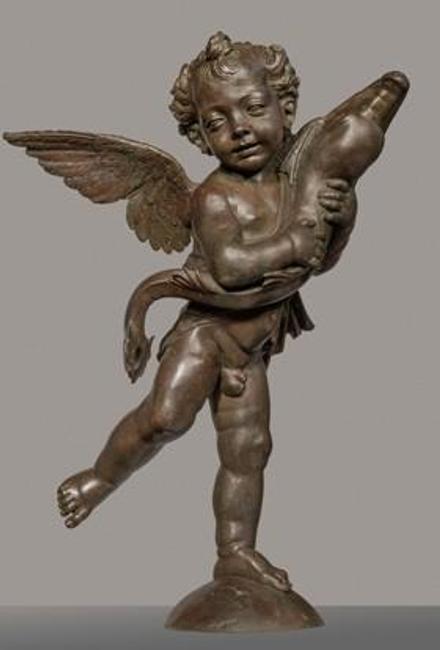
As a sculptor, Verrocchio was the most important figure in Renaissance art between Donatello and Michelangelo, making works of unprecedented technical accomplishment and breathtaking naturalism and beauty. As a painter, he formed a direct link in the central chain of Florentine painting between his master, Fra Filippo Lippi, and his own pupil, Leonardo da Vinci. As a draftsman, he was a pivotal figure who explored new media techniques and functions of drawing and profoundly influenced Leonardo, Raphael, and others. As a teacher, he headed a studio that became a kind of laboratory for experimentation and innovation and helped lead to the creation of the High Renaissance in the early 16th century. It is no accident that of the founders of the High Renaissance—Leonardo, Michelangelo, and Raphael—one was the pupil of Verrocchio and the other two were trained by pupils of Verrocchio.
"A 'Renaissance man' in every way, Andrea del Verrocchio was a
pioneering, versatile artist whose talents stood out for their
brilliance," said Kaywin Feldman, director, National Gallery of Art. "We
are grateful to the institutions and private collectors, as well as to
the Bank of America and to the Buffy and William Cafritz Family Fund,
without whom this exhibition would not be possible."
"Verrocchio was a visionary," said Andrew Butterfield, the exhibition curator and an internationally recognized expert on the artist. "He had a restless imagination and a relentless drive to experiment and improve on what he or anyone else had done before. But he was also like the maestro of an orchestra who could bring together many talents and draw forth the best from them. This was one of his secrets as a teacher."
Exhibition Organization
The exhibition is organized by the National Gallery of Art in collaboration with the Fondazione Palazzo Strozzi, Florence, and the Museo Nazionale del Bargello, Florence, where a different version of the show was on view from March 9–July 14, 2019.
.Andrea del Verrocchio (c. 1435–1488)
Verrocchio had the good fortune to be born when the Medici family was rising to dominance in the cultural life of Florence, sparking a massive boom in the patronage of painting, sculpture, and architecture that completely transformed the city. Trained initially as a goldsmith, Verrocchio as a young man also learned to paint and sculpt, probably working with such luminaries as Fra Filippo Lippi, Desiderio da Settignano, and Lorenzo Ghiberti and his workshop. By the time he was about 30 years old, Verrocchio had emerged as a master of the first rank and the Medici began to entrust him to make the most important bronze sculptures in the city: first, around 1465,

a statue of David with the Head of Goliath, made as a kind of complement to or rival of
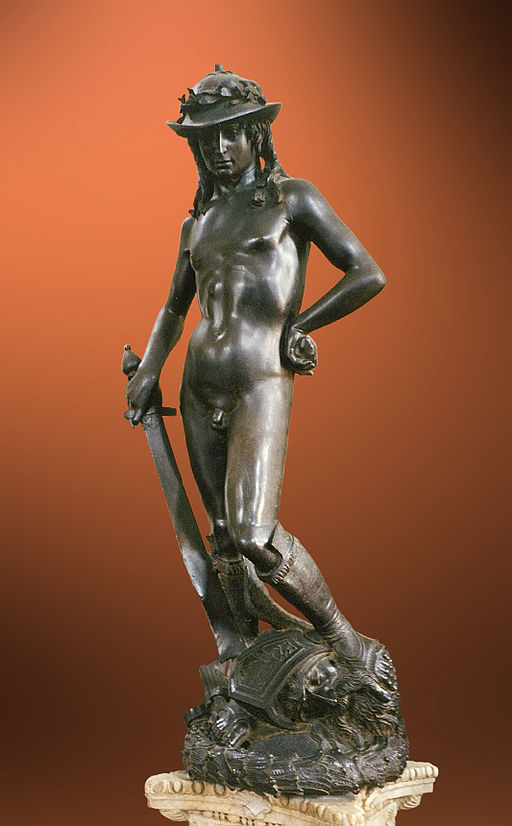
Donatello's earlier bronze of the same subject; and then in 1467 awarding Verrocchio the most prestigious sculpture commission of late-15th century Florence, the bronze group of

Christ and Saint Thomas for an outdoor niche on Orsanmichele, the church and grain reserve at the center of Florence. Taking 16 years to complete, the sculpture, upon its unveiling in 1483, was declared to be "the most beautiful work there is."
In these years he also began making other celebrated masterpieces, among them the tomb of Giovanni and Piero de' Medici (c. 1469–1473), the Cardinal Niccolò Forteguerri Monument (begun 1476), and the famous

Equestrian Monument to Bartolomeo Colleoni in Venice (begun c. 1479).
"Verrocchio was a visionary," said Andrew Butterfield, the exhibition curator and an internationally recognized expert on the artist. "He had a restless imagination and a relentless drive to experiment and improve on what he or anyone else had done before. But he was also like the maestro of an orchestra who could bring together many talents and draw forth the best from them. This was one of his secrets as a teacher."
Exhibition Organization
The exhibition is organized by the National Gallery of Art in collaboration with the Fondazione Palazzo Strozzi, Florence, and the Museo Nazionale del Bargello, Florence, where a different version of the show was on view from March 9–July 14, 2019.
.Andrea del Verrocchio (c. 1435–1488)
Verrocchio had the good fortune to be born when the Medici family was rising to dominance in the cultural life of Florence, sparking a massive boom in the patronage of painting, sculpture, and architecture that completely transformed the city. Trained initially as a goldsmith, Verrocchio as a young man also learned to paint and sculpt, probably working with such luminaries as Fra Filippo Lippi, Desiderio da Settignano, and Lorenzo Ghiberti and his workshop. By the time he was about 30 years old, Verrocchio had emerged as a master of the first rank and the Medici began to entrust him to make the most important bronze sculptures in the city: first, around 1465,

a statue of David with the Head of Goliath, made as a kind of complement to or rival of

Donatello's earlier bronze of the same subject; and then in 1467 awarding Verrocchio the most prestigious sculpture commission of late-15th century Florence, the bronze group of

Christ and Saint Thomas for an outdoor niche on Orsanmichele, the church and grain reserve at the center of Florence. Taking 16 years to complete, the sculpture, upon its unveiling in 1483, was declared to be "the most beautiful work there is."
In these years he also began making other celebrated masterpieces, among them the tomb of Giovanni and Piero de' Medici (c. 1469–1473), the Cardinal Niccolò Forteguerri Monument (begun 1476), and the famous

Equestrian Monument to Bartolomeo Colleoni in Venice (begun c. 1479).
Painting was less his principal focus, and yet he was active and
innovative in this field as well. His best-known work is his
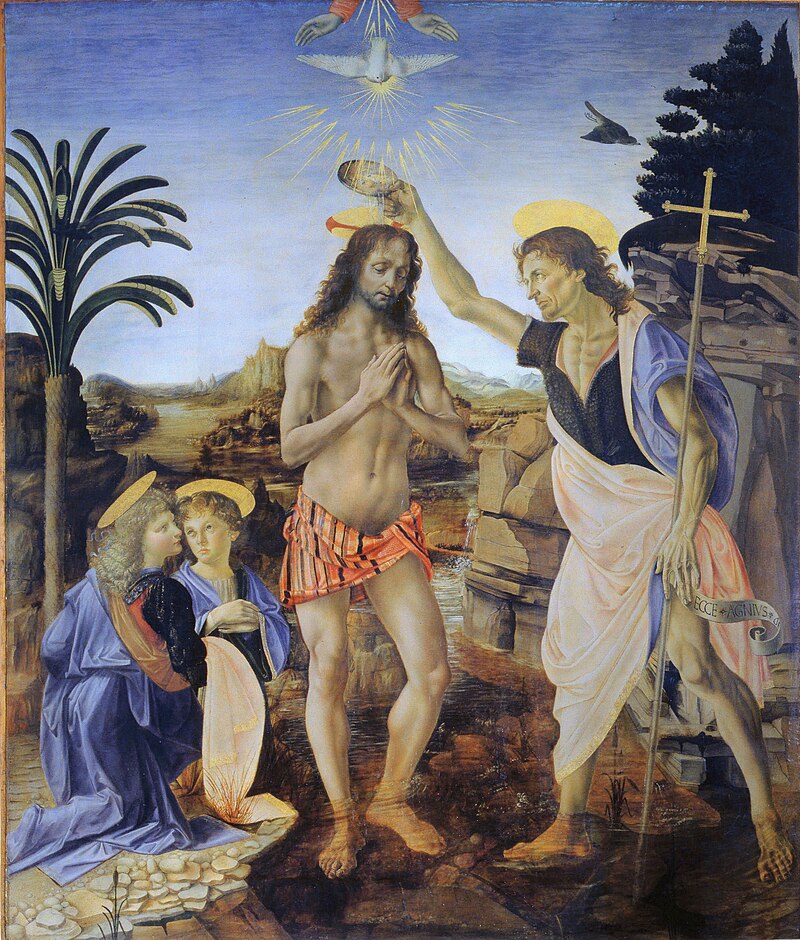
Baptism of Christ (c. 1472–1474, Gallerie degli Uffizi) made with Leonardo da Vinci, who was still his student and assistant at the time, likely in the early 1470s. Verrocchio generally took a collaborative approach to painting, employing younger masters to execute his pictures from his designs before coming in at the end to put the finishing touches on the works. Among the artists known or believed to have spent time in this capacity are Leonardo, Botticelli, Domenico Ghirlandaio, Perugino, Lorenzo di Credi, and others. A collaborative approach to painting in a master's workshop was not new in Renaissance Italy, although Verrocchio seems to have organized this painting production more thoroughly than any other painter before. Verrocchio was highly regarded in his lifetime as a painter, working for the Medici and other discerning patrons, and he was praised by contemporaries as the "spring" from which other painters drank "whatever they have that is good."
His contributions to the history of drawing are especially clear. Trained as both a goldsmith and painter, he united the drawing techniques of the two practices and made something new. His pen and ink drawings have an unprecedented vivacity and freedom, so much so that both Leonardo and Raphael were deeply influenced by them. His black-chalk and charcoal drawings have a new subtlety in the depiction of light and form; they are perhaps the first images in Italian art that unambiguously display sfumato—a kind of smoky effect in shading, which helps to amplify the apparent three-dimensionality of the forms. Sfumato was to become a fundamental component of Leonardo's painting and drawing.

Baptism of Christ (c. 1472–1474, Gallerie degli Uffizi) made with Leonardo da Vinci, who was still his student and assistant at the time, likely in the early 1470s. Verrocchio generally took a collaborative approach to painting, employing younger masters to execute his pictures from his designs before coming in at the end to put the finishing touches on the works. Among the artists known or believed to have spent time in this capacity are Leonardo, Botticelli, Domenico Ghirlandaio, Perugino, Lorenzo di Credi, and others. A collaborative approach to painting in a master's workshop was not new in Renaissance Italy, although Verrocchio seems to have organized this painting production more thoroughly than any other painter before. Verrocchio was highly regarded in his lifetime as a painter, working for the Medici and other discerning patrons, and he was praised by contemporaries as the "spring" from which other painters drank "whatever they have that is good."
His contributions to the history of drawing are especially clear. Trained as both a goldsmith and painter, he united the drawing techniques of the two practices and made something new. His pen and ink drawings have an unprecedented vivacity and freedom, so much so that both Leonardo and Raphael were deeply influenced by them. His black-chalk and charcoal drawings have a new subtlety in the depiction of light and form; they are perhaps the first images in Italian art that unambiguously display sfumato—a kind of smoky effect in shading, which helps to amplify the apparent three-dimensionality of the forms. Sfumato was to become a fundamental component of Leonardo's painting and drawing.
Exhibition Highlights
Verrocchio: Sculptor and Painter of Renaissance Florence is the first comprehensive exhibition to present his sculptures, paintings, and drawings together as a group. Driven by a passion for inquiry and innovation, Verrocchio shows the cross-fertilization he embodied through the combination of ideas and practices from the variety of media in which he worked. Among these important groupings of works on view together in the exhibition for the first time are three images of ideal beauty created in different media—

Lady with Flowers (c. 1475) in marble,
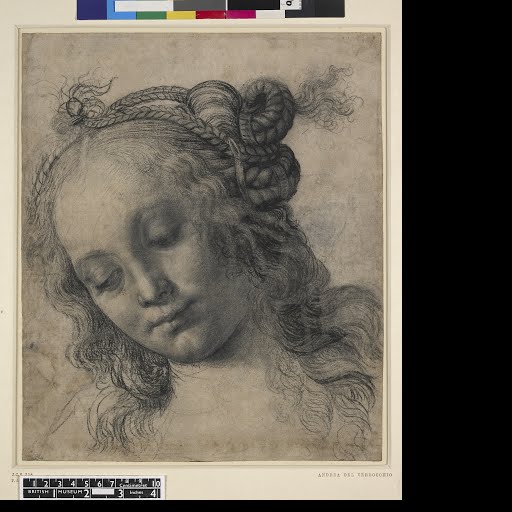
and the black-chalk drawing, Head of a Woman with Braided Hair (c. 1475/1478), alongside the Gallery's
Ginevra de' Benci (1474/1478) by Leonardo.
The exhibition brings together Verrocchio's sculptures in a variety of material, including bronze, marble, painted and unpainted terracotta, terra cruda (unbaked clay), plaster, gilded silver, and agate. This presentation allows viewers to see the range not only of Verrocchio's materials but also of his artistic practice, from initial, quick compositional sketches to exquisite completed works.

Among the sculptural masterpieces on view is the celebrated statue David with the Head of Goliath (c. 1465, Museo Nazionale del Bargello, Florence). With its elegant design, tensely graceful movement, and absorbing facial expressions, it may be Verrocchio's earliest statue in bronze and probably was made for Piero de' Medici, the father of Lorenzo the Magnificent.
Verrocchio: Sculptor and Painter of Renaissance Florence is the first comprehensive exhibition to present his sculptures, paintings, and drawings together as a group. Driven by a passion for inquiry and innovation, Verrocchio shows the cross-fertilization he embodied through the combination of ideas and practices from the variety of media in which he worked. Among these important groupings of works on view together in the exhibition for the first time are three images of ideal beauty created in different media—

Lady with Flowers (c. 1475) in marble,
and the black-chalk drawing, Head of a Woman with Braided Hair (c. 1475/1478), alongside the Gallery's
Ginevra de' Benci (1474/1478) by Leonardo.
The exhibition brings together Verrocchio's sculptures in a variety of material, including bronze, marble, painted and unpainted terracotta, terra cruda (unbaked clay), plaster, gilded silver, and agate. This presentation allows viewers to see the range not only of Verrocchio's materials but also of his artistic practice, from initial, quick compositional sketches to exquisite completed works.
Among the sculptural masterpieces on view is the celebrated statue David with the Head of Goliath (c. 1465, Museo Nazionale del Bargello, Florence). With its elegant design, tensely graceful movement, and absorbing facial expressions, it may be Verrocchio's earliest statue in bronze and probably was made for Piero de' Medici, the father of Lorenzo the Magnificent.
A core group of Verrocchio's paintings is on view in the same room
for the first time in the exhibition, except for the

Madonna di Piazza (1475/1485, Pistoia Cathedral, San Zeno) and the

Baptism of Christ (c. 1468–1475, Gallerie degli Uffizi, Florence), providing a rare opportunity to see and understand his mastery as never before.
Several of the paintings on view have not traveled to the United States prior to this exhibition, including
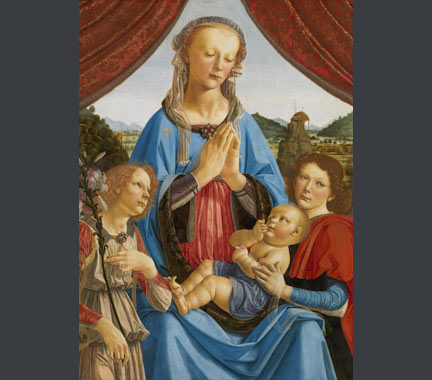
Madonna and Child with Two Angels (c. 1470/1474)
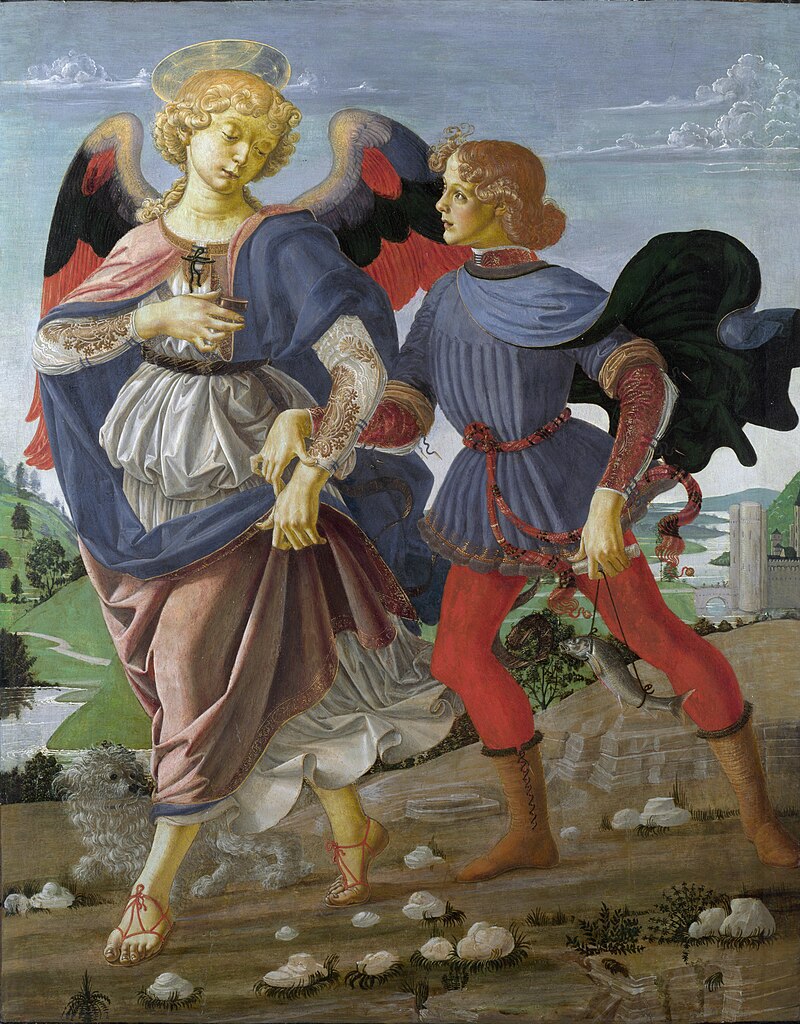
and Tobias and the Angel (c. 1470)—both from the National Gallery, London—which show Verrocchio's collaboration with Leonardo and other assistants in his workshop.
Verrocchio's highly personal technique and style of execution in his drawing exemplify the relationship between sculpture and painting and depict his original and experimental combinations of different media. Several preparatory drawings for his sculptures and paintings are on view in the exhibition, including studies of nudes, animals, drapery, and funerary monuments, as well as one of his earliest surviving drawings—Study of the Madonna Adoring the Child (c. 1470).
Technical Study of Verrocchio's Masterpieces
Technical research for the exhibition was realized by Gallery conservators Dylan Smith, Robert H. Smith Research Conservator in the department of object conservation, and Elizabeth Walmsley, senior painting conservator, and Gallery scientist John K. Delaney, senior imaging scientist in the scientific research department. They were assisted by a distinguished team of conservators and scientists from various international institutions. Modern methods of analysis allowed the investigations of Verrocchio’s works to take place in advance and at their respective institutions, providing a wealth of new observations that inform and enrich the exhibition and accompanying catalog.

Madonna di Piazza (1475/1485, Pistoia Cathedral, San Zeno) and the

Baptism of Christ (c. 1468–1475, Gallerie degli Uffizi, Florence), providing a rare opportunity to see and understand his mastery as never before.
Several of the paintings on view have not traveled to the United States prior to this exhibition, including

Madonna and Child with Two Angels (c. 1470/1474)

and Tobias and the Angel (c. 1470)—both from the National Gallery, London—which show Verrocchio's collaboration with Leonardo and other assistants in his workshop.
Verrocchio's highly personal technique and style of execution in his drawing exemplify the relationship between sculpture and painting and depict his original and experimental combinations of different media. Several preparatory drawings for his sculptures and paintings are on view in the exhibition, including studies of nudes, animals, drapery, and funerary monuments, as well as one of his earliest surviving drawings—Study of the Madonna Adoring the Child (c. 1470).
Technical Study of Verrocchio's Masterpieces
Technical research for the exhibition was realized by Gallery conservators Dylan Smith, Robert H. Smith Research Conservator in the department of object conservation, and Elizabeth Walmsley, senior painting conservator, and Gallery scientist John K. Delaney, senior imaging scientist in the scientific research department. They were assisted by a distinguished team of conservators and scientists from various international institutions. Modern methods of analysis allowed the investigations of Verrocchio’s works to take place in advance and at their respective institutions, providing a wealth of new observations that inform and enrich the exhibition and accompanying catalog.
The Gallery's research includes the first comprehensive survey of
Verrocchio's bronze sculpture, combining careful visual examination,
alloy analysis with portable x-ray fluorescence spectrometry, and
x-radiography. In addition to the major bronzes presented in the
exhibition, such as David with the Head of Goliath and his Candelabrum
(1468–1469), the study considers works that could not be present.
Investigation of Verrocchio's Tomb of Cosimo de' Medici (by 1467) and
Tomb of Giovanni and Piero de' Medici (c. 1470–1473) in the Church of
San Lorenzo in Florence offers new insights into these remarkable
multimedia monuments. A new interpretation of the casting technique of
Verrocchio's Christ and Saint Thomas from Orsanmichele is also given.
Considered together, these new observations offer a clearer
understanding of the innovative methods Verrocchio used to design and
execute his bronzes, as well as new insights into their chronology,
including the proposal of an earlier date for Putto with a Dolphin (c.
1465/1480).
For the exhibition, a select group of Verrocchio's paintings was intensively examined. Noninvasive chemical imaging techniques and point analysis (x-ray fluorescence and multi- and hyperspectral reflectance spectroscopies) were used to confirm Verrocchio's palette and better understand the paint handling and techniques. Two distinct interpretations of the Madonna and Child (c. 1465/1470; c. 1470/1472) from the Gemäldegalerie in Berlin were considered, as well as Tobias and the Angel (c. 1470) from the National Gallery, London—all of which are on view in the exhibition. In addition, the Gallery's advanced high-resolution infrared spectral imaging cameras were used to study Andrea del Verrocchio and Leonardo da Vinci's Baptism of Christ in the collection of the Gallerie degli Uffizi. The spectral images obtained reveal differences among the figures regarding the paint buildup and use of materials that further our understanding about the working methods of artists in Verrocchio's workshop.
For the exhibition, a select group of Verrocchio's paintings was intensively examined. Noninvasive chemical imaging techniques and point analysis (x-ray fluorescence and multi- and hyperspectral reflectance spectroscopies) were used to confirm Verrocchio's palette and better understand the paint handling and techniques. Two distinct interpretations of the Madonna and Child (c. 1465/1470; c. 1470/1472) from the Gemäldegalerie in Berlin were considered, as well as Tobias and the Angel (c. 1470) from the National Gallery, London—all of which are on view in the exhibition. In addition, the Gallery's advanced high-resolution infrared spectral imaging cameras were used to study Andrea del Verrocchio and Leonardo da Vinci's Baptism of Christ in the collection of the Gallerie degli Uffizi. The spectral images obtained reveal differences among the figures regarding the paint buildup and use of materials that further our understanding about the working methods of artists in Verrocchio's workshop.
Exhibition Curators
The exhibition is curated by Andrew Butterfield, an internationally recognized historian whose monograph The Sculptures of Andrea del Verrocchio (Yale University Press 1997) won the prestigious Mitchell prize. Collaborators include Gretchen A. Hirschauer, associate curator of Italian and Spanish painting, and Alison Luchs, curator of early European sculpture—both from the National Gallery of Art, Washington; and Lorenza Melli, curator of the Corpus of Italian Drawings 1300–1500/Rome-Munich-Florence, based at the Kunsthistorisches Institut/Max-Planck Institut, Florence. The exhibition was conceived by the late Eleonora Luciano (1963–2017), associate curator of sculpture and decorative arts, National Gallery of Art, and is dedicated to her memory.
The exhibition is curated by Andrew Butterfield, an internationally recognized historian whose monograph The Sculptures of Andrea del Verrocchio (Yale University Press 1997) won the prestigious Mitchell prize. Collaborators include Gretchen A. Hirschauer, associate curator of Italian and Spanish painting, and Alison Luchs, curator of early European sculpture—both from the National Gallery of Art, Washington; and Lorenza Melli, curator of the Corpus of Italian Drawings 1300–1500/Rome-Munich-Florence, based at the Kunsthistorisches Institut/Max-Planck Institut, Florence. The exhibition was conceived by the late Eleonora Luciano (1963–2017), associate curator of sculpture and decorative arts, National Gallery of Art, and is dedicated to her memory.